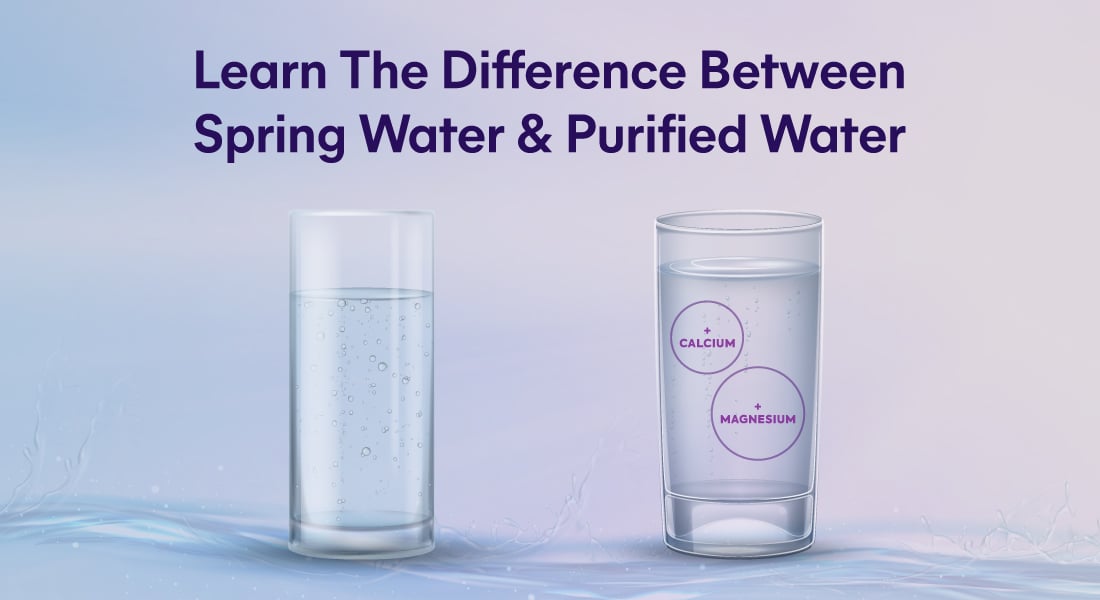
Staying hydrated is so underrated that we don’t realize how important water is in our lives! We hardly realize how water can impact our daily lifestyle and our bodies. From regulating our body temperature and nutrient absorption to digestion and keeping our skin healthy, water plays a major role in keeping us moving throughout the day.
More than that, knowing your water type is essential too! For similar reasons, people have become particular about the kind of water they want to drink. It’s of no surprise that the need to drink pure and safe water has risen significantly. This is why major companies have come up with a vast range of options for purified water! Of course, it is not limited to bottled water or packaged water that you see on the store shelves. People have started opting for spring water and even RO water filters to get the best drinking water experience.
Speaking of that, people have bifurcated water into two major categories - purified water and spring water. Let’s understand both of them in detail first.
What Is Spring Water?
Spring water is usually described as a kind of water that comes from natural sources like groundwater collected from rain or water flowing from the mountains and valleys. Most people prefer drinking it because it goes through the valleys and rough paths of the hills, which naturally filtrate it making it purer and mineral-rich.
Spring water also carries a parallel perception that it is usually free from pollutants and other man-made contaminants, making it one prime reason why people prefer drinking it.
What do you picture when you hear the term ‘Spring Water?’
If you picture a blissful environment with smoothly flowing water out of mountains and nothing but cleanliness around, it’s time to rethink. Spring water may be coming from such clean, azure places, but it undergoes a few procedures before getting packed. Because it comes from natural sources, there can be chances that the spring water may have certain impurities that require a manual filtration process before the EPA approves it to be acceptable for drinking. The man-made filtration treatment for spring water also retains the existing minerals to keep the essence intact.
What Is So Good About Spring Water?
If you are wondering if spring water is purer and healthier for you, then here are a few reasons why you are right:
It comes from a natural source
Not polluted via man-made contaminants (in some cases)
Tastes great
Mineral-rich
What Can Be The Disadvantages Of Spring Water?
Although it is mineral-rich, spring water may have a few cons too. Read below:
Environmental concerns: depleting accessible natural resources trucking in single-use bottles
Expensive
Drinking water only, not used for cooking or pets
Can sometimes contain natural and man-made contaminants including microplastics
What Is Purified Water?
Purified water is water extracted from natural and man-made water sources, including wells, lakes, rivers, aquifers, and canals. It is usually treated at the municipal levels first in manners related to the contaminants identified during testing. Then individuals and families desiring a higher standard of purity and taste will treat the water further at the point of use with additional filtration such as the Home Master® HydroPerfection® with its 9-stages of filtration, sterilization and enhancement. This multi-stage Reverse Osmosis system makes the water clean, mineral-rich and refreshing enough to turn routine hydration into a pleasure. With the help of technology, reverse osmosis (RO) systems make it easier for you to have water up to 99% free of contaminants, bacteria, rust, microplastics and other harmful pollutants depending on the application.
Usually, river or surface water in its natural form may contain a TDS of nearly 1000 ppm as per EPA, which is unsuitable for drinking. RO systems remove excess TDS and other hazardous contaminants, making it suitable for consumption and for other domestic purposes.
However, the purification process, or filtration process, as they say, may eliminate not just the harmful contaminants and pollutants but also remove the essential minerals from the water to purify it. This is where the remineralization systems can come to the rescue.
Here is a simple breakdown. You need water for nearly every activity, from drinking to other household activities such as cooking, cleaning, laundry, etc.
So how do you ensure that the water you utilize is safer? With the help of RO water filters, RO water systems, or remineralization systems, you can remove the TDS, sediment, chemicals and other contaminants that cause foul tastes and odors.
What Are The Disadvantages Of Reverse Osmosis Purified Water?
RO Purified water may meet the standards of EPA but may lack a few things such as:
Some water waste
RO Installation & maintenance costs
Purified water is the need of the hour. As we see the statistics stated in an article from Comfy Living, most drinking water consumed by US citizens comes from the tap (62%). Ultimately, most households will opt for tap water. It may require a basic purification process that can be easily done with a home RO water system.
Which One Is Better?
It is definitely tough to pick the right fit for you unless you have clarity on the below-mentioned factors:
- If you like bottled/packaged water or prefer drinking water at home
- If you would be able to afford expensive bottled water every day
- If you want to have filtered or purified water accessible everywhere in your house
- If you want to cut down on plastic waste by avoiding packaged water
Both spring water and purified water are good in their own senses, depending on your needs. However, if you opt for spring water, it gets risky to deal with the potential microplastics, and if you opt for purified water, it may carry a higher initial cost, even though it creates financial and environmental savings in the long-run. To overcome this, you can find a solution that helps you get the best of both worlds.
It is easier to opt for purified water. But, it can also have minerals like calcium and magnesium in it if you have a patented remineralization system like the one from Home Master®. The best part is that you can install it either undersink or in a basement, and utilize it for drinking, cooking, pet and plant waterting. This alternative can not only meet EPA guidelines but also gives you an elite drinking experience with other surprising features.
Speaking of features, if you opt for Home Master RO®, here is what it offers you:
They have a faster fill rate of 4.5 seconds than conventional tankless RO systems with a fill rate of 18 seconds. This means you don’t have to wait for the water to fill.
Home Master RO systems are mainly known for reducing waste by 80%, which is a step closer to reducing global water wastage.
The optional non-electric permeate pump reduces the TDS creep known to plague some Tankless RO systems..
Lastly, this non-electric pump that works even during power outages. When the lights go out - the Home Master still works.
If you have a plan to install a whole house or zero-waste system at your house, you can take a look at the Whole House Water Filter by Home Master®. Explore other excellent solutions with cutting-edge technology at The Perfect Water.
